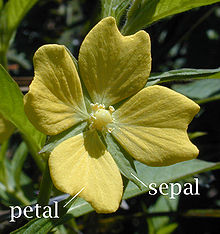calyx
Jump to navigation
Jump to search
English[edit]


Alternative forms[edit]
Etymology[edit]
From Latin calyx, from Ancient Greek κάλυξ (kálux, “case of a bud, husk”). Doublet of chalice and kelch.
Pronunciation[edit]
Noun[edit]
calyx (plural calyces or calyxes)
- (botany) The outermost whorl of flower parts, comprising the sepals, which covers and protects the petals as they develop.
- Meronym: sepal
- (zoology, anatomy) Any of various cup-like structures.
- A chamber in the mammalian kidney through which urine passes.
- The crown containing the viscera of crinoids and similar echinoderms, entoprocts, and the polyps of some cnidarians.
- A funnel-shaped expansion of the vas deferens or oviduct of insects.
- A flattened cap of neuropil in the brain of insects.
Derived terms[edit]
Translations[edit]
the sepals of a flower
|
anatomy: structure in kidney
|
zoology: crown of crinoid
|
Further reading[edit]
 calyx on Wikipedia.Wikipedia
calyx on Wikipedia.Wikipedia  calyx (botany) on Wikipedia.Wikipedia
calyx (botany) on Wikipedia.Wikipedia  calyx (anatomy) on Wikipedia.Wikipedia
calyx (anatomy) on Wikipedia.Wikipedia - Douglas Harper (2001–2024) “calyx”, in Online Etymology Dictionary.
Latin[edit]
Etymology[edit]
From Ancient Greek κάλυξ (kálux, “case of a bud, husk”).
Pronunciation[edit]
- (Classical) IPA(key): /ˈka.lyks/, [ˈkälʲʏks̠]
- (modern Italianate Ecclesiastical) IPA(key): /ˈka.liks/, [ˈkäːliks]
Noun[edit]
calyx m (genitive calycis); third declension
- The bud, cup, or calyx of a flower or nut.
- A plant of two kinds, resembling the arum, perhaps the monk's hood.
- (by extension) The shell of fruits, pericarp.
- (by extension) An eggshell.
- A fitting on a Roman pipe
Declension[edit]
Third-declension noun.
| Case | Singular | Plural |
|---|---|---|
| Nominative | calyx | calycēs |
| Genitive | calycis | calycum |
| Dative | calycī | calycibus |
| Accusative | calycem | calycēs |
| Ablative | calyce | calycibus |
| Vocative | calyx | calycēs |
Derived terms[edit]
Descendants[edit]
See also[edit]
References[edit]
- https://web.archive.org/web/20160925020435/https://en.oxforddictionaries.com/definition/calyx
- https://dictionary.cambridge.org/dictionary/english/calyx
- “calyx”, in Charlton T. Lewis and Charles Short (1879) A Latin Dictionary, Oxford: Clarendon Press
- calyx in Gaffiot, Félix (1934) Dictionnaire illustré latin-français, Hachette.
Categories:
- English terms derived from a Pre-Greek substrate
- English terms borrowed from Latin
- English terms derived from Latin
- English terms derived from Ancient Greek
- English doublets
- English 2-syllable words
- English terms with IPA pronunciation
- Rhymes:English/ælɪks
- Rhymes:English/ælɪks/2 syllables
- English lemmas
- English nouns
- English countable nouns
- English nouns with irregular plurals
- en:Botany
- en:Zoology
- en:Anatomy
- Latin terms derived from Ancient Greek
- Latin 2-syllable words
- Latin terms with IPA pronunciation
- Latin lemmas
- Latin nouns
- Latin third declension nouns
- Latin masculine nouns in the third declension
- Latin terms spelled with Y
- Latin masculine nouns